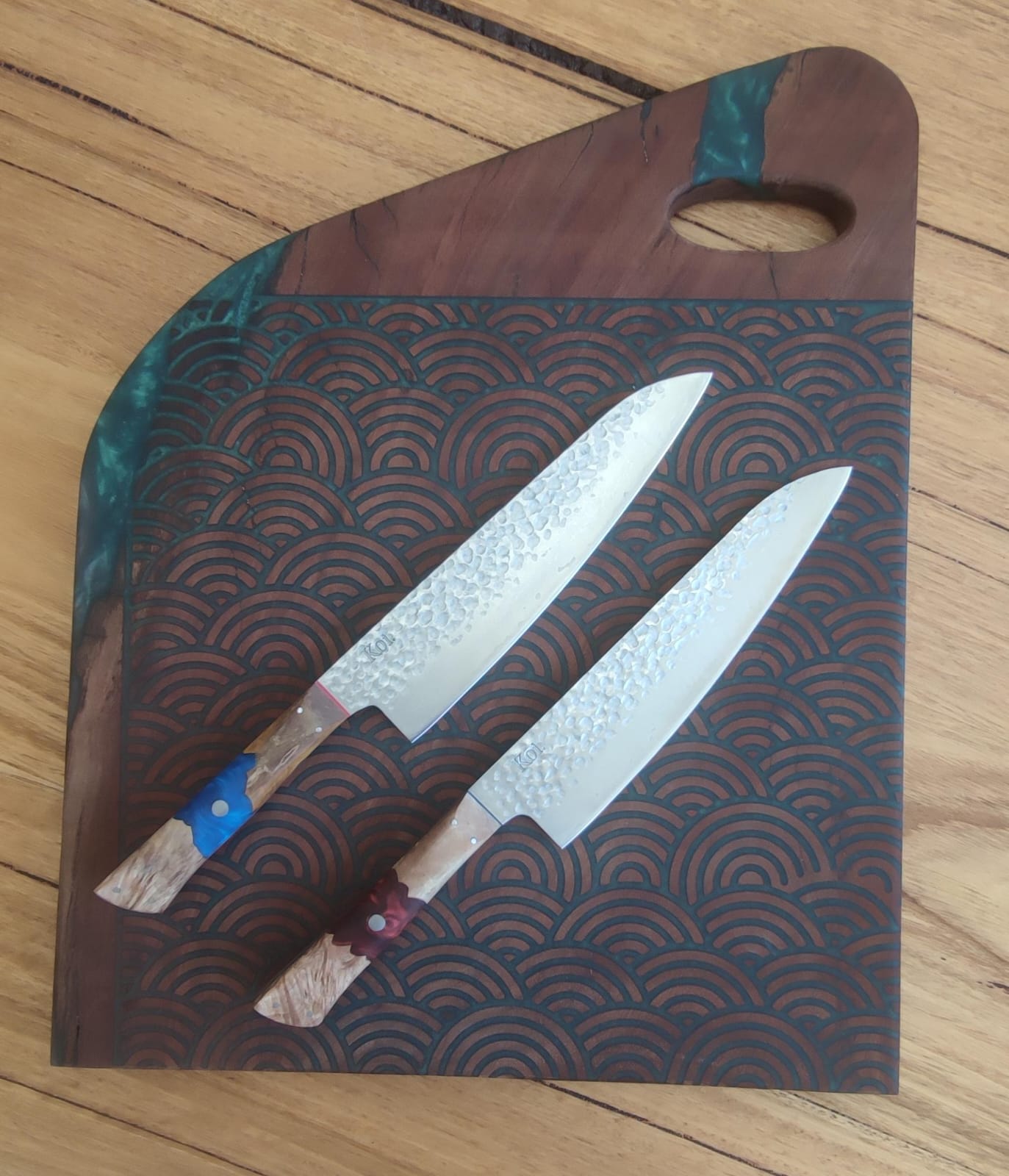Jigane
The Jigane is the untempered blacksmith section of a knife blade. The exquisite pattern on the surface of the steel is created by folding and forging the iron repeatedly with great care.
Bocho
Bocho is a Japanese term for "knife." Usually appended as a suffix to the name of a type of knife (for example, Deba Bocho), also known as Hocho.
Aogami
"Aogami" refers to a particular kind of high-carbon Japanese steel graded as Blue Steel #1, Blue Steel #2, and Blue Super. It is named after the blue paper used to cover steel and is commonly used for Honyaki knives.
Brunoise
A blend of finely chopped veggies cooked in butter and used to flavor sauces and soups.
Burr
It is a metal curvature at the cutting edge's tip. The burr, in other words, is a tiny fold of metal on the opposite side of the edge you are grinding.
Cai Dao
A Chinese vegetable cleaver that serves various purposes in a Chinese kitchen is frequently referred to as the Chinese chef's knife.
Ejiri
"Butt" is either the rear of the handles or a tang that runs through.
Due to their metal construction, tang pommels are more desirable. As a result, you may use it to pound anything, but a wooden or plastic handle would quickly crack under repeated hits.
E
The Japanese term for a knife's handle. A well-made knife must have an ergonomic grip that enables optimal cutting effectiveness. Typically, a knife handle has two scales on each side. Some knives come with a single handle that is molded to the blade.
Wa-Handle
A typical wooden handle for a traditional Japanese knife. It is commonly classified as having a D form, an oval shape, or an octagonal shape. It has a blade-forward balance and a lighter overall feeling.
Kakumaki
A ring or cap usually made of metal that reinforces the end of a handle, stick, or tube and guards against wear and splitting.
Kissaki
The Japanese term for blade tip. The tip of certain knives is considered to incorporate the point, although it's preferable to conceive of them as two separate components. Cutting that requires precise, specialized work frequently uses this edge area.
Sheepsfoot
A sheepsfoot blade features a straight cutting edge and a rear spine that bends downward to meet the straight edge and form a false point. The spine is unsharpened. A sheepsfoot's primary use is for slicing and cutting where a point is neither desired nor required. It also creates better balance through the middle of the knife.
Ago
Ago, a Japanese name for the knife's chin, and Hamato, a term for the heel's corner.
Machi
A 5mm long narrow strip of metal between the notch at the end of the blade's neck - emoto and the handle. It can be found on numerous Japanese blades but never on western knives.
When a knife features machi, the indicated blade length covers the entire length of the knife blade up to the machi notch, not just the blade Ago.
Hagane
The Japanese term for the strong, high-carbon steel core makes up the blade's cutting edge.
Mizu-Honyaki
Relates to Honyaki knives with different alterations. The blade's spine is smeared with mud and allowed to dry before being heated to the correct temperature and quenched in water. The spine is softer and springy, allowing the blade some flexibility.
San-Mai
The strong blade core is laminated with softer outer layers using a welding steel technique. In essence, this is Awase on the Hagane's two sides, but not over the spine.
Kirenaga
A knife's ability to keep its edge is referred to as kirenaga in Japanese. In other words, how long it retains its sharpness. Obviously, the greater the kirenaga, the better.
Honba-Tsuke
The procedure of honing the true edge on a knife supplied from the factory without one. For instance, Aritsugu knives are supplied in this way.
Grantons
The Granton edge is a sequence of oval dimples along the knife blade that is commonly seen on Santoku knives. Grantons, which alternate along the blade, are also known as dimples, indents, divots, scallops, and kullens. When cutting, a Granton edge on a kitchen knife creates a little air pocket between the blade and the food.
Shiso
It is known as Japanese Basil in the Western world. The flavor of shiso leaves is distinct and delicate. Sashimi, sala, omelet, and other meals use it.
Naruto-Giri
Naruto-Giri translates as "Spiral Tide Cut." Typically used for squid. First, parallel incisions are made on the square piece of squid with the knife perpendicular to the board, then the piece is flipped over, rotated 90°, and rolled; well, you can put Shiso leaves in there.
Urasuki
The backside of the single-beveled Japanese knives has a concave surface. It aids in reducing drag during cutting.
Hirazukuri
The sashimi slicing technique involves holding the knife perpendicular to the fish and pulling it back at a 45° angle.
Usuizukuri
The sashimi slicing method is is similar to Sogizukuri; however, the slices are 1mm thick and translucent.
Echizen
Echizen is a Japanese city in Fukui Prefecture. The city boasts the most cultural resources in Fukui Prefecture, including several old castle ruins and prehistoric archeological sites.
Seki
A tiny settlement in Japan's Gifu Prefecture. Renowned throughout history as the nexus of samurai swordsmithing from the 13th century. Currently considered one of the leading producers of contemporary Japanese kitchen cutlery, including knives.




